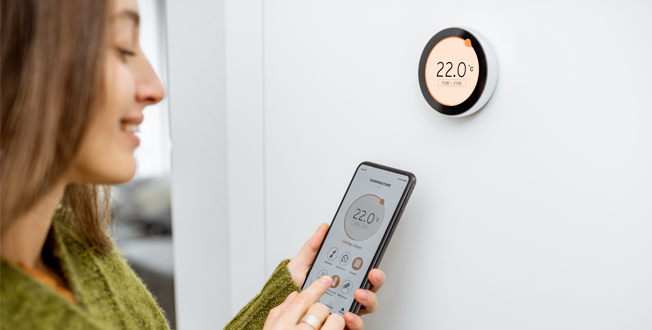IoT: When opportunity rings the connected doorbell

The market for Consumer Internet of Things (IoT) devices is growing fast, particularly in the home IoT segment, and it offers MVNOs a host of opportunities for growth. Here we consider how MVNOs and new entrants can take advantage of eSIM capabilities to harness burgeoning consumer interest in home IoT to power revenue growth.
Australians’ appetite for connection as well as the convenience, innovation and delight of connected devices is undiminished. According to research by Telsyte more than two thirds (69%) of Australians have consumer IOT devices at home and around half a million consumers started their smart home journey during the past 12 months. In 2021, there was an average of 20.5 internet-connected devices per household in Australia. This number is forecast to reach 33.8 by 2025 amid growing demand for consumer Internet of Things (IoT) devices and applications, especially in the home. While enterprise or business IoT applications have attracted a lot of focus due to the size of the segment, McKinsey says “the value of B2C applications is growing quickly, spurred by faster-than-expected adoption of IoT solutions within the home.”
McKinsey attributes the accelerating growth in Home IoT to a couple of factors. The first is the strong growth of device categories such as chore automation, energy management and control, and security and safety.
Buyer behaviour is the second factor. When someone buys into home IoT, they tend to end up going all in and buying multiple devices over time.
Furthermore, the consultancy sees scope for growth among those who currently don’t have consumer IoT devices. McKinsey’s research found “non-users frequently exhibit behaviours that indicate latent demand for connected security and utility solutions.” Those behaviours include accidentally leaving lights (51%) or leaving TVs or other appliances on (41%), while over a third “wonder what’s happening at home while they are away”, and 31% can’t remember if they have locked their doors or windows.
A multi-billion dollar opportunity
The growing demand for home IoT devices is set to translate into a rapid growth in the value of the market. Omdia projects the global smart home market value to exceed AU$265.24 billion in 2025, representing a compound-annual growth rate (CAGR) of 24.1%.
Service providers have an opportunity to carve out a substantial share of the market within their core niches. As an Accenture study puts it: “Already a credible and trusted provider of connected services… service providers could offer convenient support across all digital needs and assure that Consumer IoT devices and services are safe and easy to use.” Further validation of this approach comes in the same research that found: “Of those who own or plan to purchase connected home services, 71% would choose a telecom operator.”
The typical model is to offer subsidised devices for a monthly fee of a few dollars per month. There is a significant incremental revenue on offer when considering the average home IoT user has multiple devices.
Win with stellar consumer IoT experiences
MVNOs can win in the home IoT market by offering great user experiences and addressing current consumer concerns around set-up and management, reliability, and security and privacy. eSIM capabilities can help.
Seamless activation
eSIM enables MVNOs to offer a smooth activation experience that avoids multi-step processes or digging out WiFi passwords. Consumers simply scan a code to activate the service or it can be integrated into the purchase. For example, a retailer sells an eSIM-enabled smart security system to a consumer in store. The checkout assistant activates the eSIM service during purchase and connects it to the user’s account. The product is ready to work out of the box when the buyer gets home.
Such frictionless activation makes it an easy choice for consumers considering adding another home IoT device. And with emerging technologies like Matter making it easier to build smart ecosystems with devices across providers, it's even more important to ensure the activation process is keeping pace.
Ongoing support
As people connect more devices, the complexity in dealing with them increases. If a device connected to home Wi-Fi is not working as expected, the user may have to diagnose the fault (in conjunction with the device supplier’s support team, if they have one). The fault may lie with the device or the Wi-Fi connection, or something else, but it is on the user to identify where the problem occurs.
If home IoT devices are connected to a hub using technology such as Zigbee, which then connects to a data service through the mobile network, the MVNO can offer support to the customer. We can check any faults on the Zigbee hub and reset it if necessary, helping the service provider speed up the fault resolution and offer a better customer experience.
Reliability
Some of the most popular IoT use cases are also the most important to consumer daily life. Security, wellness monitoring, and utility management are all tasks where reliability of the solution is a primary concern for consumers.
Connectivity is an important consideration here. Home Wi-Fi performance is often influenced by the amount of traffic going through the resident’s router or the internet service provider’s network. According to Accenture’s study, 65% of consumers are concerned that smart home tech is not yet reliable enough. Their concern is real. For instance, if the home wifi is down, how do you open your wifi enabled front door lock? To deliver additional reliability the IoT network needs to remain connected even if a power outage is affecting the home.
Our mobile network provides a highly resilient and robust connectivity for smart home devices and applications, meaning customers can be confident their IoT devices will function as expected.
Security
Consumers are keen to use home IoT devices, but they also want to know their devices and data are secure. The big advantage for consumers in using the mobile network is that the MVNO can ensure only the right people can access the devices linked to the Zigbee hub when it is set up appropriately. Devices connected to the Zigbee hub do not have individual IP addresses. Insecure devices with their own IP addresses – such as those connecting over Wi-Fi networks – offer a possible route for malicious actors.
Take the next step
The home IoT market is on a steep growth trajectory. The appetite among users is evident and the barriers to buying and simply activating devices are coming down thanks to the power of eSIM. MVNOs that enter the market now will be ideally placed to capture demand and generate additional revenue opportunities and are well placed to become trusted connectivity providers as their customers adopt this new wave of technology.
If you’d like to find out how you can use eSIM to be at the forefront of home IoT services, contact us today.
